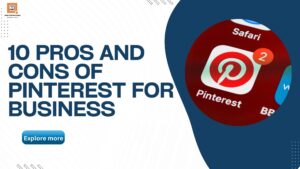Within the dynamic world of digital marketing, Pinterest has become an effective platform for businesses to demonstrate their goods and services. Pinterest presents a special chance for marketers with its visually attractive design and a user base that actively looks for ideas and inspiration.
But like any marketing tactic, getting the most out of your Pinterest representation depends on knowing how to maximize your return on investment (ROI).
We’ll go into detail on using analytics and insights to calculate the return on investment of your Pinterest marketing.
The Power of Pinterest Marketing

Before we delve into the analytics, let’s understand why Pinterest is a valuable marketing channel. Unlike other social media platforms, Pinterest is a visual discovery engine, where users actively search for inspiration, ideas, and products. This user behavior positions Pinterest as a platform where consumers are not just scrolling aimlessly but actively seeking out products or services.
Pinterest users are often in a mindset ready to make decisions – whether it’s planning a wedding, decorating a home, or finding a new recipe. This makes Pinterest an ideal space for businesses to showcase their offerings and connect with users who are closer to the purchasing stage.
Setting Objectives and Key Performance Indicators (KPIs)
Before you can measure your Pinterest marketing ROI, it’s crucial to establish clear objectives and identify the key performance indicators (KPIs) that align with your business goals. Whether it’s increasing brand awareness, driving website traffic, or boosting sales, defining your objectives will guide your Pinterest strategy and subsequent analytics.
For instance, if your primary goal is to increase website traffic, your KPIs might include clicks, click-through rates (CTR), and traffic sources. On the other hand, if you’re focusing on brand awareness, metrics such as impressions, repins, and engagement becomes more relevant.
Pinterest Analytics: Unveiling Performance Metrics
Pinterest offers a robust analytics platform that provides valuable insights into the performance of your Pins and overall account. To access Pinterest Analytics, you need to have a business account. Once set up, you can explore a wealth of information to measure the effectiveness of your marketing efforts.
1. Impressions and Reach
Impressions and reach are fundamental metrics that indicate how many times your Pins have been seen and the unique audience reached. Monitoring these metrics over time can help you understand the visibility of your content and its potential impact on your target audience.
2. Engagement Metrics
Engagement metrics, including saves, clicks, and close-ups, offer insights into how users interact with your Pins. Saves reflect the number of times users have saved your Pins to their boards, indicating a higher level of interest. Clicks measure the number of times users have clicked on your Pins to visit your website or learn more about the product.
3. Audience Insights
Understanding your audience is key to crafting content that resonates with them. Pinterest provides audience insights, including demographics, interests, and devices used. Analyzing this data allows you to tailor your content to better suit the preferences of your target audience.
4. Conversion Tracking
To directly tie your Pinterest marketing efforts to business outcomes, consider implementing conversion tracking. This feature allows you to track actions taken on your website after someone clicks on your Pin. Whether it’s making a purchase, signing up for a newsletter, or completing a form, conversion tracking provides a clear picture of your return on investment.
Calculating Pinterest Marketing ROI
Now that you have a comprehensive understanding of Pinterest analytics, let’s explore how to calculate your Pinterest Marketing ROI.
1. Establishing Costs
To calculate ROI, you first need to determine the costs associated with your Pinterest marketing efforts. This includes the time and resources spent on content creation, advertising budget (if applicable), and any other expenses related to your Pinterest strategy.
2. Quantifying Returns
Returns can take various forms, depending on your objectives. For e-commerce businesses, returns might include sales revenue generated directly from Pinterest. If your goal is lead generation, returns could be measured by the number of sign-ups or inquiries originating from Pinterest.
3. ROI Formula
The formula for calculating ROI is straightforward:
ROI=(Returns−Costs /Costs)×100
This formula expresses ROI as a percentage, providing a clear indication of the profitability of your Pinterest marketing efforts.
Leveraging Pinterest Analytics for Optimization

Beyond calculating ROI, Pinterest analytics also play a crucial role in optimizing your strategy for better results. Here are some tips to leverage analytics for continuous improvement:
1. A/B Testing
Experiment with different Pin formats, visuals, and copy to identify what resonates best with your audience. A/B testing allows you to compare the performance of two or more variations of a Pin to determine which elements drive better results.
2. Content Calendar Refinement
Use insights from Pinterest Analytics to refine your content calendar. Identify the times when your audience is most active and schedule your Pins accordingly. Consistent analysis will help you adapt to changing trends and keep your content strategy relevant.
3. Keyword Optimization
Pinterest is a search engine, and users often discover content through searches. Utilize keywords relevant to your business in Pin descriptions, titles, and boards. Regularly analyze the performance of Pins associated with specific keywords to refine your approach.
4. Ad Performance Evaluation
If you’re running Pinterest ads, closely monitor their performance through analytics. Identify top-performing ads and allocate more budget to them, while optimizing or pausing underperforming ones. This iterative process ensures that your advertising budget is invested where it delivers the most value.
Conclusion
In the dynamic world of digital marketing, staying ahead requires not just a presence on popular platforms but a strategic and data-driven approach. Pinterest, with its unique user behavior and search-oriented platform, offers a wealth of opportunities for businesses to connect with their audience.
By delving into Pinterest analytics and insights, businesses can measure the impact of their marketing efforts, calculate ROI, and refine their strategies for optimal results. When it comes to implementing Pinterest to its fullest as an effective marketing tool will be to remain knowledgeable and flexible as the platform develops.




